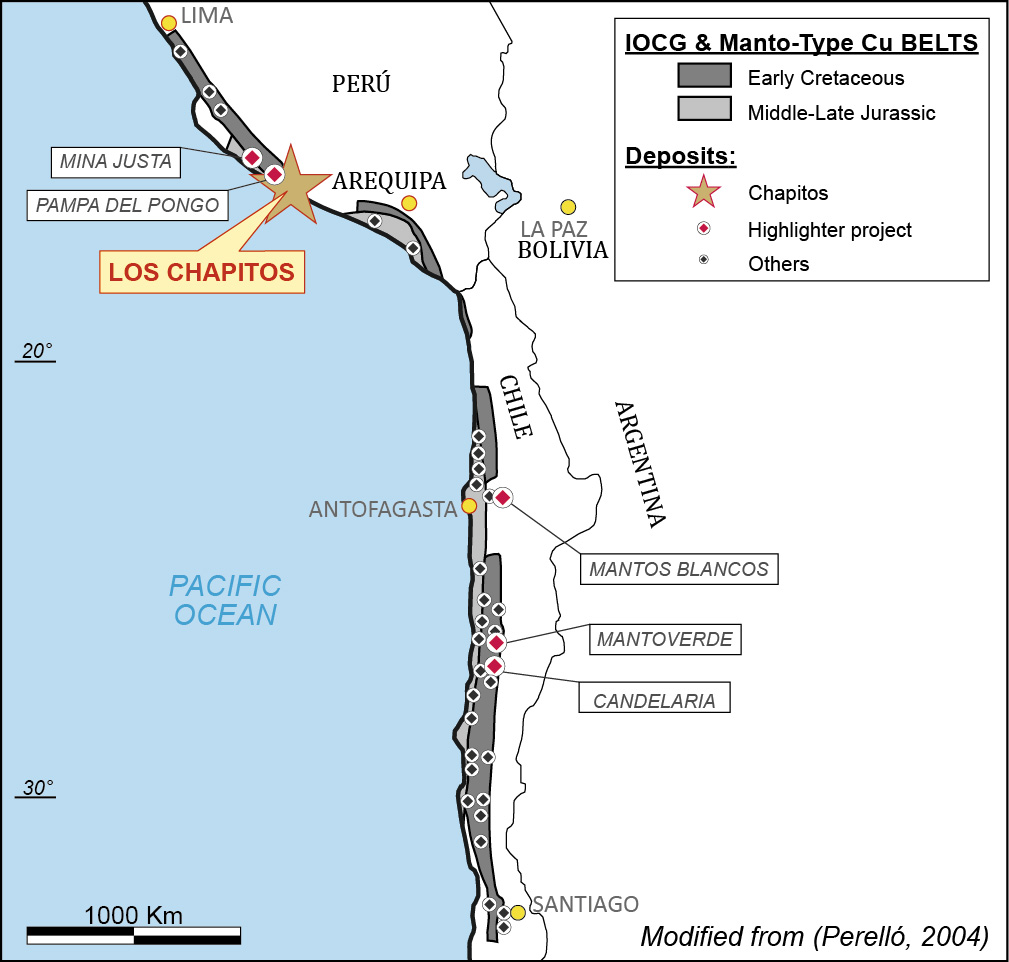The Los Chapitos project represents a style of deposit known as IOCG (Iron Oxide-Copper-Gold) that extends down the Peruvian coast into Chile and includes such deposits as Mina Justa (Peru), Mantos Blancos (Chile), and La Candelaria (Chile), to name but a few (read more). IOCG deposits are particularly attractive exploration targets due to their high grades and frequent coproduct metals (gold and silver).
The following table and map some of the more significant project in Chile and closer home in Peru.
| Deposit | Tonnage (Mt) | Fe (%) | Cu (%) | Au (g/t) | Ag (g/t) | Data source |
| Mina Justa | 347 | 0.71 | 0.03 | 3.83 | Chen et al., 2010a | |
| Pampa de Pongo | 953 | 44.7 | Chen et al., 2010a | |||
| Candelaria (*) | 600.9 | 0.52 | 0.12 | 1.76 | SKR Consulting.,2018 | |
| Mantos Blancos | 500 | 1.0 | Ramírez et al., 2006 | |||
| Mantoverde | 400 | 0.52 | 0.11 | Benavides et al., 2007 | ||
| Marimaca | 70 | 0.6 | 0.11 | Marimaca Copper, Jan. 15, 2020 |
IOCG Deposits – A Geological Summary
IOCG deposits are hosted between the Coastal Batholith and the volcanic-sedimentary rocks of Cretaceous to Jurassic age along the western edge of the Andean mountains between latitudes 10° S and 31° S and run from the central coast of Perú extending discontinuously to northern-central Chile.
The activity of the Jurassic-Early Cretaceous volcanic arc in the coast produced the rocks of the Copara, Guaneros, Rio Grande, and Chocolate Formations in Peru and Punta del Cobre and La Negra Formation in Chile that were subsequently dissected by major regional fault systems. In Peru the Tunga and Treinta Libras faults control the Mina Justa and Pampa de Pongo deposits and splays extend down to the Chapitos project.
These plutonic rocks form batholiths that host mesothermal gold, copper and lead-zinc vein systems. The Los Chapitos Property lies on the junction of these two metallogenic belts, 15 to 20 km inland from the Pacific coast (NI-43-101 & 43-101F1 TECHNICAL REPORT No. 327, David Burga, P.Geo. Effective Date: March 19, 2018, Signing Date: April 3, 2018).
Alteration is often related to regional metamorphism and can include Sodic, Sodic-calcic, Potassic, Calcic, Hydrolytic, and Argillic alteration.
The deposits are developed as structurally controlled bodies, breccias, mantos and veins with a mineralization assemblage of magnetite, musketovite, specular hematite, chalcopyrite, bornite, chalcocite and, depending on oxidation level, malachite, chrysocolla and atacamite.
“The IOCG deposits display close relations to the plutonic complexes and broadly coeval fault systems. Based on deposit morphology and dictated in part by lithological and structural parameters, they can be separated into several styles: veins, hydrothermal breccias, replacement mantos, calcic skarns and composite deposits that combine all or many of the preceding types. The vein deposits tend to be hosted by intrusive rocks, especially equigranular gabbrodiorite and diorite, whereas the larger, composite deposits (e.g. Candelaria-Punta del Cobre) occur within volcano-sedimentary sequences up to 2 km from pluton contacts and in intimate association with major orogen-parallel fault systems”. Sillitoe, 2003. Iron Oxide-copper-gold Deposits an Andean View.


